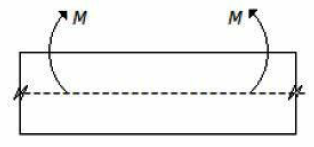Reversed Joule cycle is known as
Carnot cycle
Bell-Coleman cycle
Rankine cycle
Stirling cycle
Correct Answer :
B. Bell-Coleman cycle
Related Questions
The ultimate analysis of coal consists of the determination of the percentage of
Carbon
Hydrogen and nitrogen
Sulphur and ash
All of these
When shear force at a point is zero, then bending moment is _________ at that point.
Zero
Minimum
Maximum
Infinity
A thin cylindrical shell of diameter (D) and thickness (t) is subjected to an internal pressure (p). The ratio of longitudinal strain to volumetric strain is
(m - 1)/ (2m - 1)
(2m - 1)/ (m - 1)
(m - 2)/ (3m - 4)
(m - 2)/ (5m - 4)
The value of one bar (in S. I. units) is equal to
1 × 102 N/m2
1 × 103 N/m2
1 × 104 N/m2
1 × 105 N/m2
Reversed joule cycle is called
Carnot cycle
Rankine cycle
Brayton cycle
Bell Coleman cycle
The capacity of a strained body for doing work on the removal of the straining force, is called
Strain energy
Resilience
Proof resilience
Impact energy
The processes occuring in open system which permit the transfer of mass to and from the system, are known as
Flow processes
Non-flow processes
Adiabatic processes
None of these
Brayton cycle consists' of following four processes
Two isothermals and two isentropic
Two isentropic and two constant volumes
Two isentropic, one constant volume and one constant pressure
Two isentropic and two constant pressures
When a gas is heated at constant pressure
Its temperature will increase
Its volume will increase
Both temperature and volume will increase
Neither temperature not volume will increase
The layer at the centre of gravity of the beam as shown in the below figure, will be

In tension
In compression
Neither in tension nor in compression
None of these
Kelvin-Planck's law deals with
Conservation of work
Conservation of heat
Conversion of heat into work
Conversion of work into heat
In order to know whether a column is long or short, we must know its
Ultimate shear stress of the column
Factor of safety
Torque resisting capacity
Slenderness ratio
After reaching the yielding stage while testing a mild steel specimen, strain
Becomes constant
Starts decreasing
Increases without any increase in load
None of the above
A bar of copper and steel form a composite system, which is heated to a temperature of 40°C. The stress induced in the copper bar will be
Tensile
Compressive
Shear
Zero
A shaft revolving at ω rad/s transmits torque (T) in Nm. The power developed is
T.ω watts
2π. T.ω watts
2π. T.ω/75 watts
2π. T.ω/4500 watts
The isothermal and adiabatic processes are regarded as
Reversible process
Irreversible process
Reversible or irreversible process
None of these
When a gas is heated at constant volume
Its temperature will increase
Its pressure will increase
Both temperature and pressure will increase
Neither temperature nor pressure will increase
The thermal efficiency of an ideal gas turbine plant is given by (where r = Pressure ratio)
rγ - 1
1 - rγ - 1
1 - (1/r) γ/γ - 1
1 - (1/r) γ - 1/ γ
The heat and work are mutually convertible. This statement is called __________ law of thermodynamics.
Zeroth
First
Second
Third
The ratio of lateral strain to the linear strain within elastic limit is known as
Young's modulus
Bulk modulus
Modulus of rigidity
Poisson's ratio
When a thin cylindrical shell is subjected to an internal pressure, the volumetric strain is (where ε₁ = Hoop strain, and ε₂ = Longitudinal strain)
2ε₁ - ε₂
2ε₁ + ε₂
2ε₂ - ε₁
2ε₂ + ε₁
Second law of thermodynamics defines
Heat
Work
Internal energy
Entropy
Stirling and Ericsson cycles are
Reversible cycles
Irreversible cycles
Semi-reversible cycles
Quasi-static cycles
The root mean square velocity of the gas molecules is given by (where k = Boltzmann's constant, T = Absolute temperature, and m = Mass of one molecule of a gas)
√(KT/m)
√(2KT/m)
√(3KT/m)
√(5KT/m)
The variables which control the physical properties of a perfect gas are
Pressure exerted by the gas
Volume occupied by the gas
Temperature of the gas
All of these
Charles' law states that all perfect gases change in volume by __________ of its original volume at 0°C for every 1°C change in temperature, when pressure remains constant.
1/27th
1/93th
1/173th
1/273th
A cylindrical section having no joint is known as
Joint less section
Homogeneous section
Perfect section
Seamless section
The efficiency of Ericsson cycle is __________ Carnot cycle.
Greater than
Less than
Equal to
None of these
The unit of Young's modulus is
mm/mm
kg/cm
Kg
kg/cm²
The hard coke is obtained when carbonisation of coal is carried out at
300° to 500°C
500° to 700°C
700° to 900°C
900° to 1100°C
